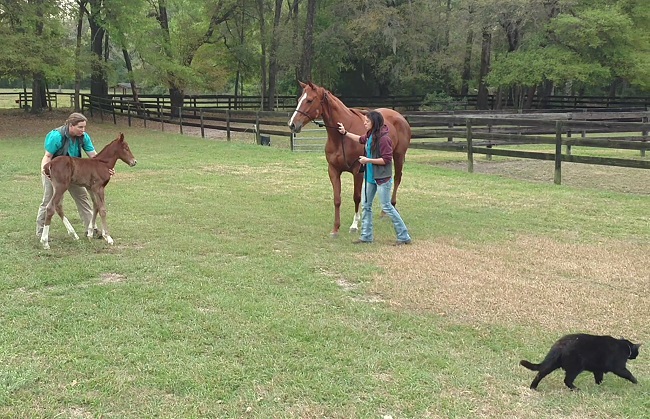So, you’ve got a brand new foal, and some questions…
When should my foal first be seen by a vet?
This is a tricky question, because most foals enjoy making their debut in the middle of the night. Do you call the doc immediately? Do you wait until morning? If all looks good, does the vet need to come at all? In short, yes. It doesn’t hurt to call the vet immediately when the foal is born, check in again in the morning, and check back as often as you like afterwards. Don’t worry, our docs understand what mares are like, and they won’t be mad if you wake them up in the middle of the night. Now, sometimes when I stay over at Dr. Lacher’s house, she gets a bit aggravated when I wake her up at 5 am by making biscuits on her back, but that’s a slightly different situation.
If your mare & foal are acting normal and have followed the 1-2-3 rules (stand within 1 hour, nurse within 2 hours, and pass the placenta within 3 hours after birth), your foal can be examined the next day. Ideally the new foal exam should happen at least within the first 24 hours after birth. However, if you suspect ANYTHING is wrong in the meantime with mare or foal, you need one of the docs out right away.
That all-important First Milk
Let’s say your mare is one of the special ones, and decides to foal at noon. All went well with foaling, and mare and foal are acting normal and comfortable. Should you just have the vet out the same day to get that first checkup over with? Well, you can, but you will probably end up paying for 2 separate farm calls. There is an excellent blood test, called an IgG test, that your vet will perform at baby’s first checkup which determines whether or not he has received enough colostrum (first milk). However, this test can only be performed at 8-12 hours after birth at the earliest! If you think about it, that makes sense: first, the foal has to nurse, then, colostrum has to get absorbed across the foal’s GI tract, then the IgG from the colostrum has to make it to the foal’s bloodstream in order to show up on the test.
So, why not just wait 48 hours until the first check up? Again, the reason has to do with that first milk. The foal’s gut only stays “open” for a short period of time. That means, the foal can only absorb colostrum until 48 hours after birth. By identifying if a foal has a low IgG at 24 hours, the vet still has time to correct the problem before the gut “closes.” Horses, I tell ya…this wouldn’t be the case if a cat had designed them!
What does the vet do besides pulling blood?
 Well, I’m glad you asked! Although it may take less than 5 minutes to complete your foal’s first check up, there are a lot of subtle things the doctor is checking during that time. Of course there are the usual things that she would check on any horse: heart rate (are there any heart murmurs?), lung sounds (any amniotic fluid still crackling around in there?), and temperature (foals tend to run higher than adults- especially if they’ve just been bouncing around). Then, your vet will feel the foal’s umbilicus to determine if it is abnormally thickened or moist, check for swelling within ALL of his joints. It is common for your vet to perform a complete ophthalmic exam on a foal, as congenital cataracts, persistent pupillary membranes, corneal ulcers, and entropion (rolling in of the eyelids) are all common disorders of newborns. Additionally, the vet is gaining a lot of information from her at-a-distance exam. Can the foal stand easily? How is his conformation? Is he nursing well on both teats? Is he urinating and defecating normally, and out of the correct places? Does his behavior seem normal? How is his energy level? Is the mare acting protective and motherly?
Well, I’m glad you asked! Although it may take less than 5 minutes to complete your foal’s first check up, there are a lot of subtle things the doctor is checking during that time. Of course there are the usual things that she would check on any horse: heart rate (are there any heart murmurs?), lung sounds (any amniotic fluid still crackling around in there?), and temperature (foals tend to run higher than adults- especially if they’ve just been bouncing around). Then, your vet will feel the foal’s umbilicus to determine if it is abnormally thickened or moist, check for swelling within ALL of his joints. It is common for your vet to perform a complete ophthalmic exam on a foal, as congenital cataracts, persistent pupillary membranes, corneal ulcers, and entropion (rolling in of the eyelids) are all common disorders of newborns. Additionally, the vet is gaining a lot of information from her at-a-distance exam. Can the foal stand easily? How is his conformation? Is he nursing well on both teats? Is he urinating and defecating normally, and out of the correct places? Does his behavior seem normal? How is his energy level? Is the mare acting protective and motherly?
The best part is, by knowing within the first 24 hours of birth if there is a problem, the docs can get to correcting it right away! Once again, my Tony wisdom exceeds all expectations. Until next week, folks!
